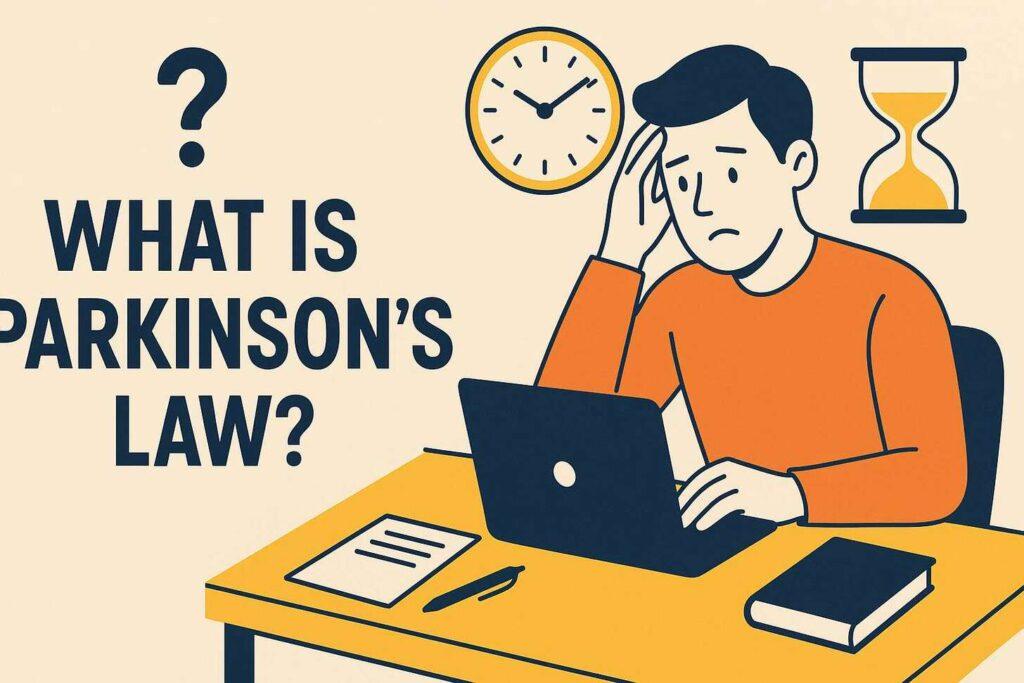Ever notice how a 30-minute task magically takes all day when there’s no deadline? That’s the Parkinson’s Law mental model in action. It explains why work stretches to fill whatever time we give it—whether we need that time or not.
This idea isn’t just theory; it’s a pattern you’ve likely seen in school projects, work meetings, or even weekend chores.
British historian Cyril Northcote Parkinson first described this phenomenon in a witty 1955 essay. He noticed how organizations created busywork to justify their existence, but the principle applies to anyone managing time. Got eight hours to finish a two-hour job? Suddenly, you’re overcomplicating decisions or scrolling social media.
Why does this matter? Because recognizing this trap helps you beat it. Short deadlines force focus. Extra time invites distractions. We’ll show how students, professionals, and teams use this insight to work smarter—not longer.
Key Takeaways
- Parkinson’s law mental model: Tasks naturally expand to use all available time, even when less is needed
- First observed in bureaucratic systems but applies to personal productivity
- Tight deadlines create urgency that boosts efficiency
- Unlimited time often leads to overthinking or procrastination
- Understanding this pattern helps you set better time boundaries
Introduction to Parkinson’s Law Mental Model
Why does sending a birthday card sometimes take longer than filing taxes? The answer lies in a timeless productivity principle, known as Parkinson’s law mental model, first spotted in 1955.
Cyril Northcote Parkinson, a British historian, uncovered this pattern while studying how organizations operate—and how they often waste time as work expands to fill the time available.
From Naval Fleets to Postcards
Parkinson’s famous essay revealed something shocking about the British Admiralty. Between 1914-1928, their naval ships dropped by 67%. But office staff grew by 78%!
More desks didn’t mean more work got done—it created more busywork instead, illustrating how work expands to fill the time available.
He illustrated this using a simple example. Imagine needing to mail a postcard. A busy person finishes in three minutes. Someone with free time?
They’ll hunt for perfect stationery, rewrite the message five times, and debate umbrella choices, showing how tasks often expand to fill time. Sound familiar?
Why This 70-Year-Old Idea Still Matters
Parkinson’s observations weren’t just about bureaucracy. They showed how humans naturally stretch tasks to fill available time. Today, this explains why work expands fill time and project deadlines often drag when deadlines are flexible:
- Projects drag when deadlines are flexible
- Quick decisions become week-long meetings
- “I’ll do it later” becomes “I’m working all night”
The original essay mixed sharp humor with uncomfortable truths. It’s why office workers in 1955 and app developers in 2024 face the same time traps. Recognizing these patterns helps us break free from the cycle where tasks expand fill time and create unnecessary work.
Common Examples of Parkinson’s Law in Daily Life

Ever plan a whole day to clean the house but somehow still run out of time? That’s Parkinson’s Law mental model in real life. It shows up when students take a week to write a one-page paper, or when office meetings drag on without clear action steps.
Even simple things—like shopping for a gift—can spiral into hours of indecision if there’s no deadline. The more time we give ourselves, the more room there is for delay, distraction, and perfectionism.
That’s why tight timeframes often lead to sharper focus and quicker action.From office meetings to schoolwork, Parkinson’s Law mental model shows up everywhere. This section highlights familiar scenarios where tasks expand unnecessarily—helping readers relate and recognize it in their own routines.
Understanding Parkinson’s Law Mental Model

Have you noticed tasks growing to fit the fill time available you allocate? This pattern shows up everywhere—from software teams fixing bugs to students writing essays.
When we set loose deadlines, simple projects become complicated puzzles, illustrating Parkinson’s Law in action.
Cyril Northcote Parkinson’s Key Findings
The British historian discovered something surprising: groups often create unnecessary work when given extra time in the context of a project. In one tech company example, a team with two weeks to fix a minor glitch ended up:
- Redesigning the error message interface
- Testing 17 browser versions
- Writing documentation nobody requested
They delivered everything on day 14—but solved the core issue in 3 hours. Sound familiar in your project management experience?
| Time Given | Task Complexity | Outcome |
|---|---|---|
| 2 hours | Basic fix | Immediate solution |
| 2 days | Added tests | Improved reliability |
| 2 weeks | Full audit | Scope creep |
Parkinson’s Law Mental Model and Science Behind Time Inflation
Why does this happen? Our brains treat available time like empty storage space. Give yourself a week for a 60-minute job, and you’ll:
- Second-guess initial decisions
- Seek “perfect” solutions
- Invent new requirements
It’s not laziness—it’s how we’re wired. Next time you schedule tasks in your project management program, ask: “Could this actually take half the time?” You might surprise yourself with the insights from Parkinson’s Law.
Bureaucracy, Scope Creep, and Procrastination

Why do generous deadlines often backfire? A 2013 study in the Journal of Economic Behavior revealed teams with extra time completed less work. Like students cramming essays at 2 AM, people naturally push tasks to the last minute—even when schedules appear flexible.
The Impact of Extended Deadlines on Productivity
Tech giants show this pattern clearly. Apple delayed its HomePod speaker for years, tweaking features users never noticed. Microsoft shelved a promised Windows 10 upgrade after endless revisions.
Both had resources and talent—but time became their enemy in understanding Parkinson’s Law mental model and managing project timelines effectively.
Real-World Office and Team Examples
Consider the Sydney Opera House. Planned as a 4-year project, it took 14 years. Why? Teams kept adding designs while materials piled up. Or software squads in 4-week sprints: 90% of work happens in week 4. Sound familiar?
Three factors drive this:
- Social loafing: Team members assume others will pick up slack
- Perfectionism: “Just one more edit” becomes 50
- Decision fatigue: Too many options paralyze progress
Next time you plan a project, ask: “What’s the smallest version that works?” Tight timelines focus minds better than blank calendars.
Why Parkinson’s Law Still Affects Productivity Today

In today’s digital world, Parkinson’s Law is more relevant than ever. With remote work and flexible schedules, tasks can easily take up hours or days. Despite having many productivity tools, it’s easy to lose focus on what’s important.
Without clear time limits, we often find ourselves stuck in a loop. We might edit slides over and over or keep checking emails instead of completing tasks. Modern teams need to be more aware of time, not just rely on more software.
Understanding how digital work environments can lead to scope creep is key. It’s the first step to taking back control and staying focused.
Strategies to Overcome Parkinson’s Law

What if tight deadlines could actually set you free? Counterintuitive as it sounds, creating artificial constraints helps beat the “work expands” trap described in Parkinson’s Law.
Let’s explore three battle-tested methods that managers can use to overcome Parkinson’s Law and turn time from enemy to ally, ensuring time available completion.
Timeboxing and Forcing Functions
Ever left your phone charger at a restaurant or coffee shop? That’s a forcing function—it makes you finish tasks before the battery dies. Apply this concept to any project:
- Schedule 20-minute meetings instead of open-ended discussions
- Use public deadlines (“Launching feature X on Friday”)
- Work in coffee shops with closing times
Pair this with timeboxing: Decide in advance how long a task should take, not how long it could. A study found teams using 90-minute timeboxes completed 23% more work than those with flexible schedules.
Understanding Parkinson’s Law helps managers grasp the amount of time required for tasks, ensuring they can effectively overcome Parkinson’s Law and optimize the work required.
Utilizing the Pomodoro Technique for Focus
The Pomodoro Technique turns your day into 25-minute sprints. Why does it work? Short bursts:
| Time Segment | Focus Level | Common Output |
|---|---|---|
| 0-25 mins | Peak concentration | Core task progress |
| 25-30 mins | Mental reset | Strategic planning |
| 30-55 mins | Sustained flow | Creative solutions |
Try this today: Set a timer for 25 minutes. When it rings, stop—even if mid-sentence. You’ll train your brain to value completed work over perfect drafts. As with applying mental models generally, consistency beats intensity.
Applying Parkinson’s Law in Project Management
What if rethinking timelines could slash project delays by 40% Savvy managers use time constraints as secret weapons. By setting intentional limits, teams deliver better results faster—without burnout.
Three Tactics for Smarter Scheduling
The PERT formula prevents guesswork. Let’s say your team builds software features. For each task, calculate:
- Optimistic time: 2 days (best-case scenario)
- Most likely: 4 days (normal workflow)
- Pessimistic: 9 days (worst-case delays)
Plug these into PERT: (2 + 4*4 + 9)/6 = 4.5 days. This beats vague “about a week” estimates.
Clear roles stop finger-pointing. The DACI framework works like this:
| Role | Responsibility |
|---|---|
| Driver | Coordinates daily tasks |
| Approver | Signs off final decisions |
| Contributors | Provide specialist input |
| Informed | Receive updates weekly |
Start planning with trade-offs, not timelines. A marketing team might choose between “launch fast with basic features” or “delay for premium options.” Once chosen, set deadlines last—like capping website redesigns at 6 weeks.
Parkinson’s Law in Personal Development and Habits

Parkinson’s Law doesn’t just affect work—it shapes personal habits, too. Want to start exercising? Without a set plan, “I’ll do it later” becomes “I didn’t do it at all.” Or think about journaling, decluttering, or learning a new skill—each one drags when we don’t create urgency.
The fix? Shrink the task. Try five pushups instead of an hour-long workout, or write two sentences instead of a full journal entry. These “micro-wins” stack up fast and make it easier to stay consistent. Small deadlines build big momentum.
Conclusion
Why does saving money feel easier with automatic transfers? It’s the same reason smaller plates help control portions—constraints drive smarter choices. By setting intentional limits, we transform how tasks expand to fill available time.
Whether managing projects or personal goals, understanding Parkinson’s Law helps us recognize the amount of time required, and shorter deadlines act like guardrails against wasted effort.
Think of time-boxing as your productivity GPS. A 25-minute focus sprint often achieves more than an unfocused hour. Teams using these methods report 30% faster completion rates while maintaining quality.
Even home organization benefits—smaller living spaces naturally limit clutter, mirroring efficient work habits. To overcome Parkinson’s Law, it’s crucial to understand the possible time we have and value each moment effectively.
The real power lies in redefining value. Instead of measuring hours spent, focus on outcomes achieved. A deeper exploration of Parkinson’s principles reveals how businesses allocate resources based on actual needs, not arbitrary budgets. Apply this mindset to daily routines: schedule urgent tasks early, use countdown timers, and celebrate quick wins.
Remember—effective work isn’t about racing clocks. It’s designing systems that make excellence inevitable. Start small: try halving one deadline this week. You might discover that less time sparks better results.


